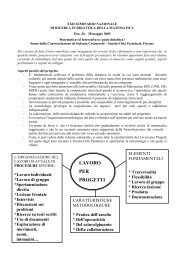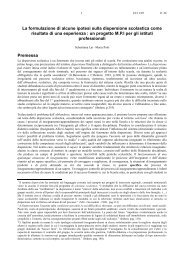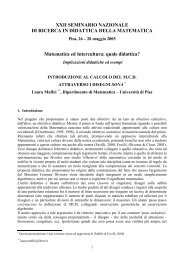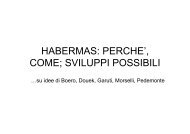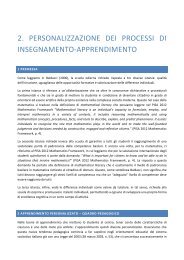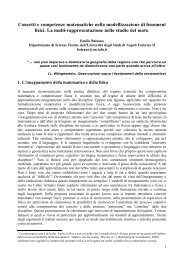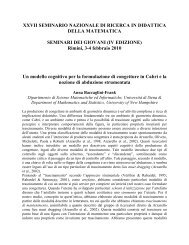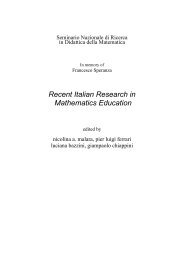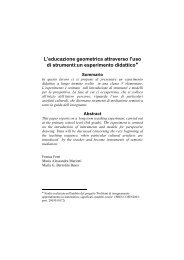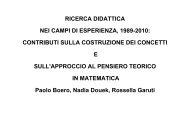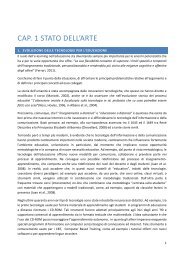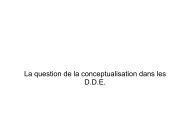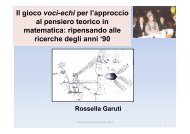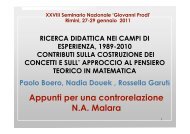vygotsky's everyday concepts/scientific concepts dialectics in school ...
vygotsky's everyday concepts/scientific concepts dialectics in school ...
vygotsky's everyday concepts/scientific concepts dialectics in school ...
Create successful ePaper yourself
Turn your PDF publications into a flip-book with our unique Google optimized e-Paper software.
VYGOTSKY'S EVERYDAY CONCEPTS/SCIENTIFIC CONCEPTS<br />
DIALECTICS IN SCHOOL CONTEXT: A CASE STUDY<br />
Nadia DOUEK<br />
IUFM de Nice, France<br />
The aim of this paper is to analyse, through a case study, how Vygotsky’s <strong>everyday</strong><br />
<strong>concepts</strong>/ <strong>scientific</strong> <strong>concepts</strong> <strong>dialectics</strong>, <strong>in</strong>tentionally promoted by the teacher, can<br />
result <strong>in</strong> an evolution of conceptualisation <strong>in</strong> mathematics. I will present the case at<br />
study, then, on a theoretical level, I will characterise conceptualisation <strong>in</strong> <strong>school</strong><br />
context. This will result from comb<strong>in</strong><strong>in</strong>g Vygotsky’s elaboration about <strong>scientific</strong><br />
<strong>concepts</strong> with Vergnaud’s def<strong>in</strong>ition of concept <strong>in</strong> a dynamical perspective <strong>in</strong>spired<br />
by the Vygotskyan <strong>dialectics</strong>. On a pragmatic level, I will specify the conditions that<br />
can favour build<strong>in</strong>g up this <strong>dialectics</strong> <strong>in</strong> <strong>school</strong>. This will be backed by Boero’s<br />
"experience fields" didactic theory, and will concern argumentation and student’s<br />
implication <strong>in</strong> experience field activities.<br />
VYGOTSKY'S EVERYDAY CONCEPTS / SCIENTIFIC CONCEPTS<br />
DIALECTICS<br />
Scientific <strong>concepts</strong> are characterised by Vygotsky (1985, Chapt. 6) through their use,<br />
as they are used <strong>in</strong> a conscious, <strong>in</strong>tentional and explicit way. They are related to other<br />
<strong>concepts</strong> <strong>in</strong> systems. They are general, have a theoretical character and can be<br />
presented through a def<strong>in</strong>ition. Everyday <strong>concepts</strong> are rich <strong>in</strong> mean<strong>in</strong>g, but their<br />
relation to systems is rather implicit. They are developed spontaneously through<br />
subject’s experience, with<strong>in</strong> culture and social context. Generally they have a local<br />
scope and do not need to be def<strong>in</strong>ed. The existence and development of <strong>everyday</strong><br />
<strong>concepts</strong> and <strong>scientific</strong> <strong>concepts</strong> are closely related: <strong>scientific</strong> <strong>concepts</strong> evolve from<br />
abstract to particular ground<strong>in</strong>gs; <strong>everyday</strong> <strong>concepts</strong> can be ref<strong>in</strong>ed <strong>in</strong>to more precise<br />
(and eventually <strong>in</strong>to <strong>scientific</strong>) <strong>concepts</strong>; but relat<strong>in</strong>g to a system and the conscious<br />
use of a concept imply that some <strong>everyday</strong> <strong>concepts</strong> have already been developed,<br />
which can back its <strong>scientific</strong> use. I wish to stress the relative and dynamical character<br />
of these two poles of the <strong>dialectics</strong>.<br />
THE EXPERIENCE FIELDS DIDACTICAL SETTING<br />
Our example comes from a second grade class <strong>in</strong>volved <strong>in</strong> the Genoa Project for<br />
primary <strong>school</strong> (20 children, about 8 years old). The aim of this Project is to teach<br />
mathematics, native language, natural sciences, history, etc… through systematic<br />
activities concern<strong>in</strong>g "fields of experience" from <strong>everyday</strong> life (Boero, 1994; Boero et<br />
al., 1995). These activities are <strong>in</strong>tended both to develop mastery of the fields of<br />
experience themselves, and to approach and develop <strong>concepts</strong> and skills belong<strong>in</strong>g to<br />
those discipl<strong>in</strong>es. For <strong>in</strong>stance, <strong>in</strong> Grade I the development of numerical knowledge is<br />
rooted <strong>in</strong> the "money" and "class history" fields of experience; moreover they allow
to promote students' argumentation as well as the use of specific symbolic<br />
representations.<br />
In the "fields of experience" didactical sett<strong>in</strong>g, a fairly common classroom rout<strong>in</strong>e<br />
consists: of <strong>in</strong>dividual production of written hypotheses on a given task; of classroom<br />
comparison and discussion of selected students' products, orchestrated by the teacher<br />
(cf Bartol<strong>in</strong>i Bussi, 1996); of <strong>in</strong>dividual written reports about the discussion; and of a<br />
classroom summary, usually constructed under the guide of the teacher and f<strong>in</strong>ally<br />
written down <strong>in</strong> the students' copybooks. In most cases, classroom summaries<br />
represent students’ reached knowledge (with possible ambiguities and hidden<br />
mistakes). F<strong>in</strong>al <strong>in</strong>stitutionalisation phases (Brousseau, 1986) are atta<strong>in</strong>ed only <strong>in</strong> few<br />
circumstances. From the researcher's po<strong>in</strong>t of view, this style of slowly evolv<strong>in</strong>g<br />
knowledge offers the opportunity to observe the transformation of students'<br />
knowledge <strong>in</strong> a favourable climate. Argumentation has a strong status <strong>in</strong> this<br />
didactical sett<strong>in</strong>g, and most problem situations, particularly <strong>in</strong> mathematics, are<br />
solved through argumentation, avoid<strong>in</strong>g manipulative activities (cf Douek, 2003).<br />
Argumentation reflects fairly well each student’s level of mastery of knowledge,<br />
his/her level of use of references, and the class' common stable references (cf Douek,<br />
1999). Justification and explanation are essential <strong>in</strong> the didactical contract. As <strong>in</strong> all<br />
Italian primary <strong>school</strong>s, the student group rema<strong>in</strong>s with the same two teachers for the<br />
first five years of primary education. Therefore didactical contracts are very stable. I<br />
must add that Italian curricula are rather loosely prescriptive around a core of<br />
necessary knowledge.<br />
Students deal with the plant cultivation experience field for about 4 months <strong>in</strong> Grade<br />
II. Students had measured wheat plants taken <strong>in</strong> a field, then had to follow the<br />
<strong>in</strong>crease <strong>in</strong> time of the heights of plants of the classroom pot. They described them<br />
and drew them on their copybooks. They solved various problems concern<strong>in</strong>g their<br />
grow<strong>in</strong>g up, which <strong>in</strong>volved mathematical knowledge; our example concerns one of<br />
those problem situations. We will consider data deriv<strong>in</strong>g from direct observation,<br />
students' texts, and videos of classroom discussions concern<strong>in</strong>g this problem situation<br />
as well as previous activities.<br />
THE CASE AT STUDY<br />
Here is the problem posed to the class:<br />
On Friday December 3, the plant <strong>in</strong> the pot, kept <strong>in</strong> class and <strong>in</strong> the light, was 26 cm<br />
tall, and the one <strong>in</strong> the dark was 7 cm tall. Today, Friday December 10, the plant <strong>in</strong> the<br />
pot kept <strong>in</strong> the light is 28 cm tall and the one <strong>in</strong> the pot <strong>in</strong> the dark is 10 cm tall. Which<br />
plant has grown the most from December 3 till now?<br />
Students had to deal with two k<strong>in</strong>ds of conceptual difficulties. The first difficulty is<br />
related to the comparison of transformations (<strong>in</strong>creases) <strong>in</strong> the additive conceptual<br />
field, a complex and new situation for them (cf Vergnaud’s categorisation, <strong>in</strong><br />
Vergnaud, 1990). The second difficulty is <strong>in</strong>herent <strong>in</strong> the students' concept of<br />
<strong>in</strong>crease, which was at the level of an <strong>everyday</strong> concept, although students were able<br />
to solve problems as “how much such plant has <strong>in</strong>creased from that date till now”,
and to compare heights of two plants. The closeness between the <strong>concepts</strong> of height<br />
and <strong>in</strong>crease added complexity. However, it will be <strong>in</strong>terest<strong>in</strong>g to see how the<br />
evolution of the conceptualisation of <strong>in</strong>crease depended on, and simultaneously<br />
favoured, the mastery of the additive field and its extension to <strong>in</strong>clude the comparison<br />
of transformations.<br />
Phase 1: Individual oral production with teacher’s mediation<br />
13 students (out of 20) engaged correctly <strong>in</strong>to the problem solv<strong>in</strong>g, through<br />
calculations and comparison of results. But they were confused when the teacher<br />
asked them to expla<strong>in</strong> their problem solv<strong>in</strong>g. Only 6 of them arrived easily at a stable<br />
correct conclusion. Some students answered “the plant that <strong>in</strong>creased the most is the<br />
one which is the tallest”. They deduced <strong>in</strong>crease from height, thus contradict<strong>in</strong>g their<br />
own numerical result. Others said “this plant <strong>in</strong>creased the most, so it is the tallest”.<br />
They deduced height from <strong>in</strong>crease, disregard<strong>in</strong>g the visible state of the plants.<br />
Perform<strong>in</strong>g the right calculations was not enough to grasp the situation as a whole. To<br />
solve problem numerically, most students <strong>in</strong>terpreted <strong>in</strong>crease as a supplementary<br />
length <strong>in</strong> the plant. But the dynamical character of <strong>in</strong>crease was not grasped with its<br />
dependence on time and the implicit fact that it may be slow or quick between two<br />
given moments: they were not able to use such an argument to <strong>in</strong>terpret the situation.<br />
Their <strong>everyday</strong> conceptualisation of <strong>in</strong>crease was not sufficient. But through<br />
argumentation guided (or stimulated, depend<strong>in</strong>g on cases) by the teacher, this concept<br />
evolved and most students became able, at least momentarily, to handle the problem<br />
situation through verbal activity, pay<strong>in</strong>g attention to the various elements of the<br />
situation, and were able to <strong>in</strong>terpret them accord<strong>in</strong>g to a hierarchy that organised<br />
calculations. Many students used an expression that became mean<strong>in</strong>gful and<br />
stabilised: “pezzo cresciuto” ("the bit that grew").<br />
The other 7 students had difficulties to master and <strong>in</strong>terpret data, and did not succeed<br />
<strong>in</strong> produc<strong>in</strong>g a solution. The teacher encouraged them (as well as 2 students out of the<br />
group of 13 who had produced a correct solution) to draw the two plants, mark the<br />
draw<strong>in</strong>g with signs correspond<strong>in</strong>g to the different heights at different dates, and<br />
follow the <strong>in</strong>creases on the draw<strong>in</strong>g. Hence for all the students the situation ga<strong>in</strong>ed a<br />
spatial character, either through the draw<strong>in</strong>g or through the image of “the bit that<br />
grew” (which is not correct <strong>scientific</strong>ally, s<strong>in</strong>ce growth is an evolution of the whole<br />
plant). This spatial frame helped most students to “see” and grasp the dynamical<br />
aspect of the plant grow<strong>in</strong>g as well as to fix for each plant the elements that need to<br />
be determ<strong>in</strong>ed and compared. Given students' mastery of the additive field, I<br />
conjecture that those spatial representations allowed the representation of numbers on<br />
the number l<strong>in</strong>e to be transferred (gradually, depend<strong>in</strong>g on students) to this new<br />
additive situation. This favoured the mathematisation of this new situation while<br />
putt<strong>in</strong>g its dynamical character <strong>in</strong>to new evidence.<br />
As a whole, student/teacher <strong>in</strong>teractions developed argumentation concern<strong>in</strong>g three<br />
types of references: reality of plants cultivation, their “stories” with their dynamical<br />
character and time dependence; schematisation through draw<strong>in</strong>g and/or its equivalent
verbal spatial organisation, which helped to master the hierarchy between dynamical<br />
and static elements (either as data or as parts of the sketched plants); and calculations<br />
that helped f<strong>in</strong>d<strong>in</strong>g and fix<strong>in</strong>g <strong>in</strong>termediate elements, but which could have been<br />
mastered abstractly and <strong>in</strong>dependently from the particular situation.<br />
Confusion due to the <strong>in</strong>sufficient <strong>everyday</strong> conceptualisation of <strong>in</strong>crease was<br />
overcome thanks to a sufficient mastery of the additive situation and related external<br />
representations (numerical, verbal, schematic). This made the situation challeng<strong>in</strong>g<br />
and atta<strong>in</strong>able at the same time. We can conjecture that such conditions made the<br />
<strong>scientific</strong>/<strong>everyday</strong> concept <strong>dialectics</strong> effective. Argumentation was the way by<br />
which that <strong>dialectics</strong> enhanced students conceptualisation. It also allowed some<br />
students to appropriate elaborate verbal expression reflect<strong>in</strong>g ref<strong>in</strong>ed understand<strong>in</strong>g<br />
of the situation. We heard sentences such as: “the plant that <strong>in</strong>creased the most is the<br />
one which was <strong>in</strong> the dark although the highest was the one <strong>in</strong> the light.”<br />
At the end of Phase 1, all students could dist<strong>in</strong>guish and calculate <strong>in</strong>creases and<br />
heights; 9 expressed the relation between them as <strong>in</strong> the excerpt mentioned above.<br />
Phase 2: comparison activity and collective discussion<br />
This text was distributed for <strong>in</strong>dividual comparison, before collective discussion:<br />
JESSICA : the plant <strong>in</strong> the dark <strong>in</strong>creased the most because it <strong>in</strong>creased 3 cm, on the<br />
contrary the plant <strong>in</strong> the warm place <strong>in</strong>creased 2 cm. I say that the one <strong>in</strong> the dark<br />
<strong>in</strong>creased the most because the centimetres of the part of the plant that <strong>in</strong>creased are the<br />
most.<br />
GIUSEPPE : the plant that <strong>in</strong>creased the most s<strong>in</strong>ce Friday, December 3 is the one <strong>in</strong><br />
the dark, because it <strong>in</strong>creased 3 cm, but the one <strong>in</strong> the warm <strong>in</strong>creased 2 cm and so 3 are<br />
more than 2. But <strong>in</strong> fact the plant which is the tallest is the one that makes 28 cm, and it<br />
is the one <strong>in</strong> the warm.<br />
Questions :<br />
1) In which way did Giuseppe and Jessica reason ?<br />
2) In Giuseppe’s text there is a consideration we cannot f<strong>in</strong>d <strong>in</strong> Jessica’s. Which one is<br />
it?<br />
This metacognitive reflection about their problem solv<strong>in</strong>g led students to share the<br />
reason<strong>in</strong>g and stabilise it with<strong>in</strong> the class, as well as to deepen, for some students, and<br />
to pursue, for the others, the effort of clarification and <strong>in</strong>terpretation of the situation.<br />
At the beg<strong>in</strong>n<strong>in</strong>g of the collective discussion, the weak <strong>everyday</strong> conceptualisation of<br />
<strong>in</strong>crease appeared aga<strong>in</strong>: many students mixed it up with height <strong>in</strong> their reason<strong>in</strong>g,<br />
even though they had been able to discrim<strong>in</strong>ate them dur<strong>in</strong>g their <strong>in</strong>teraction with the<br />
teacher. But once some students referred to the bit that <strong>in</strong>creased, the evoked spatial<br />
situation helped to restore the “right” argument. However, the draw<strong>in</strong>g was not<br />
needed anymore. A new example given by a student established another criteria to<br />
dist<strong>in</strong>guish <strong>in</strong>crease from height <strong>in</strong> relation to time: a child’s height is his/her<br />
<strong>in</strong>crease s<strong>in</strong>ce birth (note that this is rigorously true for plants, not for children…);<br />
while <strong>in</strong>crease is determ<strong>in</strong>ed <strong>in</strong> relation to two dates. All along the discussion the
arguments to <strong>in</strong>terpret and compare the texts concerned “reality” (the known<br />
development of the plants), spatial organisation, and calculations, with their<br />
hierarchical organisation.<br />
Phase 3: Individual synthesis<br />
The teacher brought the students to a synthesis by the follow<strong>in</strong>g question:<br />
Is it the same to say “which plant <strong>in</strong>creased the most” and to say “which plant is the<br />
tallest”? Why?<br />
The generality of this question aims a more <strong>scientific</strong> handl<strong>in</strong>g of the <strong>in</strong>volved<br />
<strong>concepts</strong>. 12 students out of 20 produced a general and valid synthesis, most gave<br />
examples (and some of them were creative <strong>in</strong> do<strong>in</strong>g it). 14 students referred to time. 6<br />
out of these 14 had produced a draw<strong>in</strong>g <strong>in</strong> Phase 1.<br />
A CHARACTERISATION OF SCIENTIFIC CONCEPTUALISATION IN<br />
SCHOOL CONTEXT<br />
Let us now describe <strong>scientific</strong> conceptualisation as we consider it pert<strong>in</strong>ent <strong>in</strong> <strong>school</strong><br />
context, and present a characterisation that allows to evaluate its evolution. We will<br />
use it to analyse the effect of Vgotsky’s <strong>everyday</strong> <strong>concepts</strong>/ <strong>scientific</strong> <strong>concepts</strong><br />
<strong>dialectics</strong> on conceptualisation, as well as the conditions that helped this dialectic to<br />
take place. This characterisation captures two entangled aspects: the epistemological<br />
construction, and the development of cognitive activities. Vygotsky (1986; cf<br />
Vergnaud, 2000) helps us to recognise the quality of the use of the concept, and its<br />
evolution. Vergnaud (1990) helps us to recognise explicit l<strong>in</strong>ks with experienced<br />
“reality” through reference situations and external representation; and with subject’s<br />
activity <strong>in</strong>terpreted through operational <strong>in</strong>variants 1 . External representation, <strong>in</strong><br />
coherence with the experience field didactical theory, <strong>in</strong>cludes gesture and language<br />
<strong>in</strong> the broadest way (cf Radford, 2003). We consider two characters of<br />
conceptualisation and at the same time we try to describe how to detect them:<br />
- The evolution of systemic l<strong>in</strong>ks of <strong>concepts</strong>. L<strong>in</strong>ked objects can be reference<br />
situations, external representations, other <strong>concepts</strong>, or components of <strong>concepts</strong><br />
(accord<strong>in</strong>g to Vergnaud’s def<strong>in</strong>ition). L<strong>in</strong>ks can be propositions about the objects<br />
(e.g. propositions that express properties, characteristics, analogies or differences or<br />
hierarchies), metaphors, examples, etc. Operational <strong>in</strong>variants or generalisations can<br />
underlie these l<strong>in</strong>ks.<br />
- Students’ awareness <strong>in</strong> handl<strong>in</strong>g the concept, its components or its systemic l<strong>in</strong>ks: it<br />
consists <strong>in</strong> the mastery of the concept, and the <strong>in</strong>tentional recourse to it or to some of<br />
its components, that can be detected specifically <strong>in</strong> us<strong>in</strong>g and express<strong>in</strong>g operational<br />
<strong>in</strong>variants and through us<strong>in</strong>g its external representations.<br />
AN ANALYSIS OF CONCEPTUALISATION IN OUR EXAMPLE<br />
1<br />
Vergnaud def<strong>in</strong>ed a concept as composed by the set of its reference situations, the set of its<br />
operational <strong>in</strong>variants ('schemes', theorems <strong>in</strong> actions, etc.) and the set of its symbolic<br />
representations (see Vergnaud, 1990).
Students had to discover the crucial elements of the situation and organise their<br />
hierarchical relations to back a procedure of calculation. This reflects the<br />
development of an <strong>in</strong>tentional and explicit use of additive relations and a mastery of<br />
important systemic l<strong>in</strong>ks. But they also dealt with the central notion of <strong>in</strong>crease. This<br />
<strong>everyday</strong> use of <strong>in</strong>crease was crucial to <strong>in</strong>terpret the problem situation <strong>in</strong> terms of<br />
additive relations; at the same time the possibility of <strong>in</strong>terpret<strong>in</strong>g it with the <strong>scientific</strong><br />
<strong>concepts</strong> of the additive field made it necessary, and possible as well, to develop the<br />
conceptualisation of <strong>in</strong>crease (and specially to make explicit its dependence on time).<br />
Teacher’s stimulation and direction of argumentation made this <strong>dialectics</strong> alive and<br />
productive. As a result of sett<strong>in</strong>g this dialectic, the <strong>everyday</strong> concept of <strong>in</strong>crease was<br />
made more “<strong>scientific</strong>” (though rema<strong>in</strong><strong>in</strong>g <strong>in</strong> an <strong>everyday</strong> use).<br />
Evolution of the concept of <strong>in</strong>crease<br />
Development of systemic l<strong>in</strong>ks of <strong>in</strong>crease:<br />
- dist<strong>in</strong>ction between height and <strong>in</strong>crease: It was possible thanks to the implicit<br />
relation to the number l<strong>in</strong>e, either by draw<strong>in</strong>g or <strong>in</strong>directly by mental reference<br />
(because of student’s mastery of such elements of the additive conceptual field),<br />
which contributed also to determ<strong>in</strong>e their relation to time. Increase was determ<strong>in</strong>ed as<br />
a variation of length through time;<br />
- l<strong>in</strong>k<strong>in</strong>g <strong>in</strong>crease to reference situations: The real situation made it possible through<br />
its dynamical character, thanks to the <strong>in</strong>terpretation needed to solve the problem;<br />
<strong>in</strong>deed <strong>in</strong>crease it is a variation related to time that is not really visible, but has to be<br />
elaborated. Also referr<strong>in</strong>g height to <strong>in</strong>crease s<strong>in</strong>ce birth as different from <strong>in</strong>crease<br />
between two dates had a positive effect: students had another reference situation and<br />
another explanation of the role of time at their disposal.<br />
Concern<strong>in</strong>g students’ awareness:<br />
students syntheses revealed that they assimilated this new understand<strong>in</strong>g of the<br />
concept (all of them referred to time) and were able to use it <strong>in</strong> a personal way to<br />
answer the question put <strong>in</strong> general terms (it was not possible to just repeat the newly<br />
established knowledge). The ability to determ<strong>in</strong>e and dist<strong>in</strong>guish the different<br />
components of height and <strong>in</strong>crease was related to the possibility to master and<br />
comb<strong>in</strong>e <strong>in</strong>tentionally that set of additive situations (variation of length, reference and<br />
dependence to time, and comparison of variations).<br />
Extension of the <strong>scientific</strong> conceptualisation of the additive field: comparison of<br />
additive transformations<br />
Compar<strong>in</strong>g transformations <strong>in</strong> the context of plants' <strong>in</strong>crease (familiar because of the<br />
long term work <strong>in</strong> the experience field of plant cultivation) was mean<strong>in</strong>gful and<br />
efficient: the grow<strong>in</strong>g of the plants confers to the additive situation a dynamical<br />
character and a possibility of mental spatial representation. This allowed to master<br />
and organise the various phases of calculus.<br />
Development of systemic l<strong>in</strong>ks of the additive conceptual field:
they can be identified through the relationship established between comparison of<br />
transformations and a “real” dynamical situation, as well as through schematic (direct<br />
or mental) treatments of the static visible aspects and the dynamical, only th<strong>in</strong>kable,<br />
aspects. Hierarchic organisation between the various additive calculations, <strong>in</strong> relation<br />
to their <strong>in</strong>terpretation as static or dynamical, was an operational <strong>in</strong>variant, as well as<br />
the arithmetic theorems <strong>in</strong> action underly<strong>in</strong>g the numerical treatment.<br />
Concern<strong>in</strong>g students awareness:<br />
at the beg<strong>in</strong>n<strong>in</strong>g of the sequence one part of the students mastered the additive<br />
situation only through calculations. At the end, though, all of them were able to<br />
<strong>in</strong>terpret calculations <strong>in</strong> relation to the reference situation and give examples of<br />
comparable additive situations. They revealed then a conscious mastery of this<br />
additive situation and an ability to relate it or compare it to other situations (as<br />
compar<strong>in</strong>g <strong>in</strong>creases of children by compar<strong>in</strong>g <strong>in</strong>creases between two dates, and<br />
heights as <strong>in</strong>creases s<strong>in</strong>ce “birth”).<br />
CONDITIONS THAT ALLOWED THE VYGOSTKIAN DIALECTICS TO<br />
WORK<br />
The analysis of the didactical situation put <strong>in</strong>to evidence two ma<strong>in</strong> conditions that<br />
favoured the sett<strong>in</strong>g of this <strong>dialectics</strong> and its function<strong>in</strong>g.<br />
- The important use of the “reality”, the development of various expression about it<br />
and the development of <strong>everyday</strong> <strong>concepts</strong> <strong>in</strong> <strong>school</strong> context. This comes from the<br />
experience fields didactical sett<strong>in</strong>g, which implies mak<strong>in</strong>g sure that students are<br />
sufficiently <strong>in</strong>volved <strong>in</strong> some activities related to this “reality”, and important<br />
<strong>everyday</strong> <strong>concepts</strong> are explicitly shared, and enriched with verbal and other external<br />
representation through observations and discussions. In fact, <strong>everyday</strong> <strong>concepts</strong> do<br />
not quite correspond to spontaneous ones, though they rema<strong>in</strong> <strong>in</strong> the <strong>everyday</strong> stream<br />
of conceptualisation (cf Vygotsky, 1985, Chapt. 6).<br />
- Argumentative activity managed by the teacher allowed students to <strong>in</strong>terpret the<br />
situation, express and discuss their views, handle and compare various (verbal,<br />
schematic, numerical) external representations. It helped students to assimilate the<br />
new construction, because they had to express themselves <strong>in</strong> a variety of ways to<br />
answer to a variety of detailed questions. Argumentation played a dynamical role so<br />
that the dialectic could evolve.<br />
CONCLUSION<br />
Vygotsky’s <strong>scientific</strong> <strong>concepts</strong>/<strong>everyday</strong> <strong>concepts</strong> <strong>dialectics</strong> works as a powerful<br />
model for conceptualisation <strong>in</strong> teach<strong>in</strong>g and learn<strong>in</strong>g contexts. But through<br />
observation of examples such as the one reported here, I found that it can turn out to<br />
be also an efficient tool to plan teach<strong>in</strong>g situations <strong>in</strong> order to achieve some important<br />
educational aims <strong>in</strong> mathematics. The "experience fields" didactical sett<strong>in</strong>g does use<br />
this <strong>dialectics</strong> as one of the levers to develop conceptualisation, with some specific<br />
favourable conditions:
- the development of <strong>everyday</strong> <strong>concepts</strong> <strong>in</strong> <strong>school</strong> context up to a certa<strong>in</strong> level of<br />
expression and activity <strong>in</strong> the perspective of a “mastered reality”, <strong>in</strong> parallel to the<br />
build<strong>in</strong>g of <strong>scientific</strong> conceptualisation of related notions;<br />
- the explicit root<strong>in</strong>g of mathematical <strong>concepts</strong> with<strong>in</strong> systems that may conta<strong>in</strong><br />
nonmathematical <strong>concepts</strong>, and by this way can support the students' mathematical<br />
activity by provid<strong>in</strong>g them with mean<strong>in</strong>gful references.<br />
We can also note how, <strong>in</strong> the "experience fields" didactical sett<strong>in</strong>g, a cont<strong>in</strong>uous<br />
development of argumentative skills allows to nourish the back<strong>in</strong>g of mathematical<br />
reason<strong>in</strong>g on other (and easier to master) k<strong>in</strong>ds of reason<strong>in</strong>g. As a result,<br />
argumentation can effectively move the <strong>everyday</strong> <strong>concepts</strong> /<strong>scientific</strong> <strong>dialectics</strong> under<br />
the teacher's guide.<br />
REFERENCES<br />
Bartol<strong>in</strong>i Bussi, M. (1996). Mathematical Discussion and Perspective Draw<strong>in</strong>g <strong>in</strong> Primary<br />
School. Educational Studies <strong>in</strong> Mathematics. 31, 11-41.<br />
Boero, P. (1994). Experience fields as a tool to plan mathematics teach<strong>in</strong>g from 6 to 11. In<br />
L. Bazz<strong>in</strong>i & H.G. Ste<strong>in</strong>er (Eds.), Proceed<strong>in</strong>gs of the Second Italian German Bilateral<br />
Symposium on Didactics of Mathematics. IDM Bielefeld, pp. 45-62.<br />
Boero, P.; Dapueto, C.; Ferrari, P.; Ferrero, E.; Garuti, R.; Lemut, E.; Parenti, L.; Scali, E.<br />
(1995). Aspects of the Mathematics-Culture Relationship <strong>in</strong> Mathematics Teach<strong>in</strong>g-<br />
Learn<strong>in</strong>g <strong>in</strong> Compulsory School. Proc. of PME-XIX. Recife. Vol. 1, pp. 151-166<br />
Brousseau, G. (1986). Fondements et méthodes de la didactique des mathématiques.<br />
Recherches en didactique des mathématiques. 7, 33-115.<br />
Douek, N. (1999). Argumentation and Conceptualisation <strong>in</strong> Context : A Case Study on Sun<br />
Shadows <strong>in</strong> Primary School. Educational Studies <strong>in</strong> Mathematics. 39, 89-110.<br />
Douek, N. (2003). Les rapports entre l’argumentation et la conceptualisation dans les<br />
doma<strong>in</strong>es d’expérience. Thèse. Paris : Université de Paris-V.<br />
Radford, L. (2003). Gestures, Speech and the Sprout<strong>in</strong>g of Signs. Mathematical Th<strong>in</strong>k<strong>in</strong>g<br />
and Learn<strong>in</strong>g, 5(1), 37-50<br />
Vergnaud, G.(1990). La théorie des champs conceptuels. Recherches en Didactique des<br />
Mathématiques. 10, 133-170.<br />
Vergnaud, G.(2000). Lev Vygotsky pédagogue et penseur de notre temps. Paris: Hachette<br />
Education.<br />
Vygotsky, L. S. (1985). Pensée et langage. Paris: Editions Sociales.



